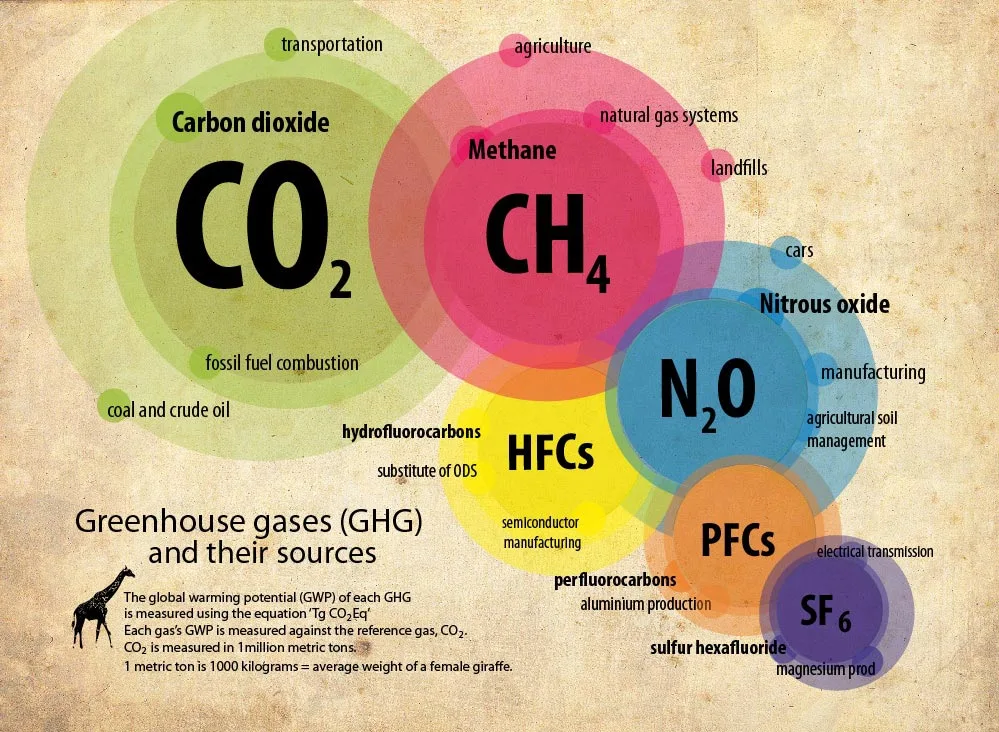Greenhouse gases are gases in Earth’s atmosphere that trap heat. They allow sunlight to enter the atmosphere freely but prevent some of the heat that the Earth would otherwise radiate back into space from escaping. This process is often referred to as the greenhouse effect, and it is crucial for maintaining the Earth’s temperature within a range suitable for life. However, human activities, particularly the burning of fossil fuels and deforestation, have significantly increased the concentrations of these gases, leading to enhanced warming and contributing to climate change.

- Carbon Dioxide (CO2):
- Natural Sources: Respiration, volcanic activity, decay of organic matter.
- Human Activities: Burning of fossil fuels (coal, oil, and natural gas), deforestation.
- Methane (CH4):
- Natural Sources: Wetlands, termites, oceans, wildfires.
- Human Activities: Livestock digestion, rice paddies, coal mining, oil and gas extraction.
- Nitrous Oxide (N2O):
- Natural Sources: Soil bacteria, oceans.
- Human Activities: Agricultural and industrial activities, burning of fossil fuels.
- Water Vapor (H2O):
- Natural Sources: Evaporation from oceans, lakes, and rivers.
- Human Activities: While human activities don’t directly emit water vapor, they can influence atmospheric water vapor levels through activities that affect other greenhouse gases.
- Ozone (O3):
- Stratospheric Ozone: Acts as a natural greenhouse gas by preventing some of the sun’s harmful ultraviolet (UV) radiation from reaching the Earth’s surface.
- Tropospheric Ozone: A human-made greenhouse gas and air pollutant formed by the reaction of nitrogen oxides (NOx) and volatile organic compounds (VOCs) in the presence of sunlight.
- Chlorofluorocarbons (CFCs), Hydrochlorofluorocarbons (HCFCs), Hydrofluorocarbons (HFCs):
- Human-Made Gases: Historically used in refrigeration, air conditioning, and aerosol propellants.
- Impact: While they have been phased out due to their role in ozone depletion, they are potent greenhouse gases.
The enhanced greenhouse effect resulting from increased concentrations of these gases is a major driver of contemporary climate change. It leads to global warming, shifts in weather patterns, rising sea levels, and other environmental changes. Monitoring and mitigating the emissions of greenhouse gases are critical components of efforts to address climate change and promote environmental sustainability.
Greenhouse Gases in Geological History
The history of greenhouse gases in Earth’s geological record provides valuable insights into the planet’s climate over millions of years. Here is an overview of key periods and events related to greenhouse gases in geological history:
- Archean Eon (4.0 – 2.5 billion years ago):
- Early Earth had an atmosphere dominated by methane (CH4) and ammonia (NH3).
- Lack of oxygen (O2) in the atmosphere during this time.
- Proterozoic Eon (2.5 billion – 541 million years ago):
- The rise of photosynthetic cyanobacteria led to the accumulation of oxygen in the atmosphere.
- Oxygen levels increased, creating a more oxygen-rich atmosphere.
- Evidence suggests episodic methane bursts during this time.
- Paleozoic Era (541 – 252 million years ago):
- Carboniferous Period (359 – 299 million years ago): High levels of atmospheric oxygen and extensive plant growth.
- Formation of vast coal deposits due to abundant plant material.
- Late Permian Period (299 – 252 million years ago): Massive volcanic activity may have released large amounts of greenhouse gases, contributing to the Permian-Triassic extinction event.
- Mesozoic Era (252 – 66 million years ago):
- Jurassic Period (201 – 145 million years ago): Warm temperatures and high CO2 levels.
- Cretaceous Period (145 – 66 million years ago): Continued warmth; decline in CO2 levels towards the end.
- Cenozoic Era (66 million years ago – Present):
- Paleocene-Eocene Thermal Maximum (PETM) (56 million years ago): Rapid global warming, likely triggered by the release of large amounts of carbon dioxide.
- Oligocene Epoch (33.9 – 23 million years ago): Cooling and a transition to more icehouse conditions.
- Miocene Epoch (23 – 5.3 million years ago): Gradual cooling; expansion of ice sheets in the late Miocene.
- Quaternary Period (2.6 million years ago – Present):
- Pleistocene Epoch (2.6 million years ago – 11,700 years ago): Cycles of glacial and interglacial periods, influenced by variations in orbital parameters.
- Holocene Epoch (11,700 years ago – Present): Relatively stable climate, allowing for the development of human civilizations.
- Anthropocene (Proposed Geological Epoch):
- The Anthropocene represents a new epoch characterized by significant human influence on Earth’s geology and ecosystems.
- Rapid increase in greenhouse gas concentrations, particularly carbon dioxide, due to human activities such as industrialization and fossil fuel combustion.
Understanding the geological history of greenhouse gases provides context for interpreting current and future climate changes. It also highlights the interconnectedness of geological, biological, and atmospheric processes that shape Earth’s climate over vast timescales.




































